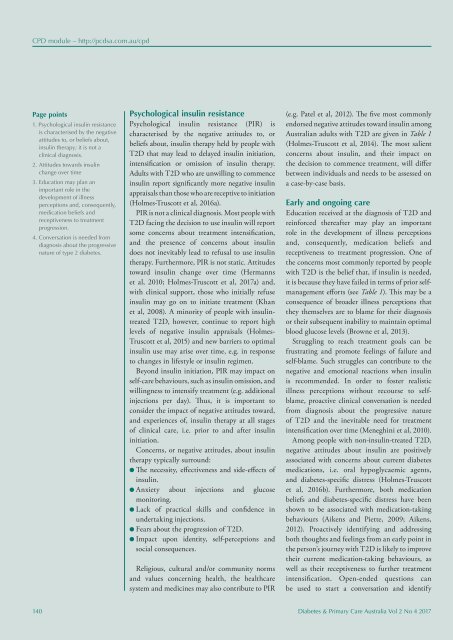DPCA 2-4_139-45
Create successful ePaper yourself
Turn your PDF publications into a flip-book with our unique Google optimized e-Paper software.
CPD module – http://pcdsa.com.au/cpd<br />
Page points<br />
1. Psychological insulin resistance<br />
is characterised by the negative<br />
attitudes to, or beliefs about,<br />
insulin therapy; it is not a<br />
clinical diagnosis.<br />
2. Attitudes towards insulin<br />
change over time<br />
3. Education may plan an<br />
important role in the<br />
development of illness<br />
perceptions and, consequently,<br />
medication beliefs and<br />
receptiveness to treatment<br />
progression.<br />
4. Conversation is needed from<br />
diagnosis about the progressive<br />
nature of type 2 diabetes.<br />
Psychological insulin resistance<br />
Psychological insulin resistance (PIR) is<br />
characterised by the negative attitudes to, or<br />
beliefs about, insulin therapy held by people with<br />
T2D that may lead to delayed insulin initiation,<br />
intensification or omission of insulin therapy.<br />
Adults with T2D who are unwilling to commence<br />
insulin report significantly more negative insulin<br />
appraisals than those who are receptive to initiation<br />
(Holmes-Truscott et al, 2016a).<br />
PIR is not a clinical diagnosis. Most people with<br />
T2D facing the decision to use insulin will report<br />
some concerns about treatment intensification,<br />
and the presence of concerns about insulin<br />
does not inevitably lead to refusal to use insulin<br />
therapy. Furthermore, PIR is not static. Attitudes<br />
toward insulin change over time (Hermanns<br />
et al, 2010; Holmes-Truscott et al, 2017a) and,<br />
with clinical support, those who initially refuse<br />
insulin may go on to initiate treatment (Khan<br />
et al, 2008). A minority of people with insulintreated<br />
T2D, however, continue to report high<br />
levels of negative insulin appraisals (Holmes‐<br />
Truscott et al, 2015) and new barriers to optimal<br />
insulin use may arise over time, e.g. in response<br />
to changes in lifestyle or insulin regimen.<br />
Beyond insulin initiation, PIR may impact on<br />
self-care behaviours, such as insulin omission, and<br />
willingness to intensify treatment (e.g. additional<br />
injections per day). Thus, it is important to<br />
consider the impact of negative attitudes toward,<br />
and experiences of, insulin therapy at all stages<br />
of clinical care, i.e. prior to and after insulin<br />
initiation.<br />
Concerns, or negative attitudes, about insulin<br />
therapy typically surround:<br />
l The necessity, effectiveness and side-effects of<br />
insulin.<br />
l Anxiety about injections and glucose<br />
monitoring.<br />
l Lack of practical skills and confidence in<br />
undertaking injections.<br />
l Fears about the progression of T2D.<br />
l Impact upon identity, self-perceptions and<br />
social consequences.<br />
Religious, cultural and/or community norms<br />
and values concerning health, the healthcare<br />
system and medicines may also contribute to PIR<br />
(e.g. Patel et al, 2012). The five most commonly<br />
endorsed negative attitudes toward insulin among<br />
Australian adults with T2D are given in Table 1<br />
(Holmes-Truscott et al, 2014). The most salient<br />
concerns about insulin, and their impact on<br />
the decision to commence treatment, will differ<br />
between individuals and needs to be assessed on<br />
a case-by-case basis.<br />
Early and ongoing care<br />
Education received at the diagnosis of T2D and<br />
reinforced thereafter may play an important<br />
role in the development of illness perceptions<br />
and, consequently, medication beliefs and<br />
receptiveness to treatment progression. One of<br />
the concerns most commonly reported by people<br />
with T2D is the belief that, if insulin is needed,<br />
it is because they have failed in terms of prior selfmanagement<br />
efforts (see Table 1). This may be a<br />
consequence of broader illness perceptions that<br />
they themselves are to blame for their diagnosis<br />
or their subsequent inability to maintain optimal<br />
blood glucose levels (Browne et al, 2013).<br />
Struggling to reach treatment goals can be<br />
frustrating and promote feelings of failure and<br />
self-blame. Such struggles can contribute to the<br />
negative and emotional reactions when insulin<br />
is recommended. In order to foster realistic<br />
illness perceptions without recourse to selfblame,<br />
proactive clinical conversation is needed<br />
from diagnosis about the progressive nature<br />
of T2D and the inevitable need for treatment<br />
intensification over time (Meneghini et al, 2010).<br />
Among people with non-insulin-treated T2D,<br />
negative attitudes about insulin are positively<br />
associated with concerns about current diabetes<br />
medications, i.e. oral hypoglycaemic agents,<br />
and diabetes-specific distress (Holmes-Truscott<br />
et al, 2016b). Furthermore, both medication<br />
beliefs and diabetes-specific distress have been<br />
shown to be associated with medication-taking<br />
behaviours (Aikens and Piette, 2009; Aikens,<br />
2012). Proactively identifying and addressing<br />
both thoughts and feelings from an early point in<br />
the person’s journey with T2D is likely to improve<br />
their current medication-taking behaviours, as<br />
well as their receptiveness to further treatment<br />
intensification. Open-ended questions can<br />
be used to start a conversation and identify<br />
140 Diabetes & Primary Care Australia Vol 2 No 4 2017
















